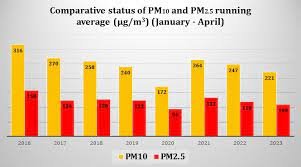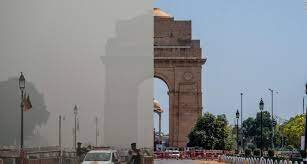As the weather surges to the onset of winter season in Northern India, Delhi fights for a clean air to breath, yet again. Despite trying harder each year, the government of the national capital is in distress all over again with the poor AQI (Air Quality Index) remaining constant.
On November 2 at around 6 am, the India Meteorological Department recorded a temperature of 18 degrees Celsius and forecast mostly clear skies. Delhi’s Air Quality Index (AQI) fell into the “very poor” category for the sixth day in a row, according to data from the Central Pollution Control Board (CPCB).
The System of Air Quality and Weather Forecasting and Research (SAFAR) indicates that Delhi’s AQI level is 343, with PM 2.5 and PM 10 being the most common pollutants.
Air Pollution in Delhi
Pollution is the term used to describe the contamination of the environment by substances that harm human health, quality of life, or the ecosystems’ ability to function naturally. Water pollution, air pollution, noise pollution, and soil contamination are the main types of pollution.
Regarding the quantities of pollutants and the steps taken to mitigate them, Delhi’s air pollution situation has changed significantly over time.
In Delhi, one major source of air pollution is vehicular pollution. The Department of Transport, Government of the National Capital Territory of Delhi, estimates that there are approximately 3.4 million vehicles in this area, with a 7% annual growth rate.

According to the urban air database published by the World Health Organization in September 2011, Delhi surpassed the maximum PM10 limit by nearly ten times, at 198 μg/m3, in third place, behind Ludhiana and Kanpur.
A recent study has revealed that breathing in the noxious air raises the incidence of type 2 diabetes and high blood pressure, coinciding with the increase in air pollution in Delhi, the nation’s capital.
The survey, which involved 12,000 inhabitants of Chennai and Delhi over a seven-year period (2010–2017), served as the basis for the report. The researchers assessed the level of air pollution in the subjects’ immediate area using satellite data and air pollution exposure models.
The study found that Delhi had average annual PM2.5 levels of 82–100μg/m3 and Chennai had average annual PM2.5 levels of 30–40μg/m3. In India, the official criteria for air quality are 40μg/m3.
Anand Vihar, Punjabi Bagh, Mundka, and other stations in Delhi reported “severe” air quality.
The Central Pollution Control Board’s data indicates that the Anand Vihar station recorded an AQI of 404, placing it in the severe category. The AQI of 415 measured at Punjabi Bagh station is classified as severe. With an AQI of 420, Mundka station recorded the worst air quality.
A number of other locations also registered very poor air quality, including Burari (AQI = 340), Dwarka Sector-8 (AQI = 370), Jahangirpuri (374), Rohini (391), and Wazirpur station (379). With an AQI of 303, the CRRI Mathura Road station recorded extremely bad air quality. The AQI of 311 obtained by the ITO station is classified as extremely poor. With an AQI of 320, Mandir Marg station recorded extremely bad air quality.
The Uttar Pradesh Central Pollution Control Board (UPPCB) reports that Sanjay Nagar in Ghaziabad recorded an AQI of 250 in the “poor” range, and Sector 62 in Noida recorded an AQI of 340 in the “very poor” category.
Impact on the health of people
The effects of PM10 exposure on the respiratory and breathing systems, risks people to lung tissue damage, cancer, and early mortality. People with chronic respiratory diseases, asthma, influenza, or the elderly are more vulnerable to the effects of particulate matter.
An excessive amount of PM2.5 exposure results in raised blood sugar levels.
According to the Guardian investigation, there was a 22% rise in the risk of diabetes for every 10μg/m3 increase in the annual average PM2.5 level in the two cities, Delhi and Chennai.

A study that was published in The Lancet in June this year estimates that 36 million people are pre-diabetic and 101 million people (or 11.4% of the population) have diabetes. According to the Lancet report, there are more diabetes in India’s cities than in its rural areas.
“Up until now, we had assumed that diet, obesity, and physical exercise were some of the factors explaining why urban Indians had higher prevalence of diabetes than rural Indians,” Dr. V. Mohan, one of the paper’s authors, told the Guardian. “This research opens our eyes”.
What are the measures taken by the Delhi Government ?
Due to an increase in dangerous pollution levels, India’s cricket authority banned fireworks from being used at the Cricket World Cup in Mumbai and New Delhi yesterday.
The Delhi administration has barred diesel buses from entering the city. In addition, building projects have been suspended within a kilometer of hotspots where the AQI level consistently hovers above 400.
On November 2, Environment Minister Gopal Rai presided over a review meeting at the Delhi Secretariat due to the increasing levels of pollution in Delhi and the National Capital Region. In hot spots when the AQI level stays near to 400, it was agreed to halt construction work within a one-kilometer radius.

The environment minister for Delhi went on to say, “As instructed by CAQM (Commission for Air Quality Management), the entry of diesel buses into Delhi has been stopped as of today.” There are eighteen teams organized for this. I kindly ask the state governments to only operate CNG, electric, or BS-VI buses out of their depots to ensure that passengers have no difficulties.”
Rai instructed the concerned department officials to call a meeting for a later time to review the Graded Response Action Plan (GRAP)-II.
“The following 15 to 20 days, starting on November 1, are crucial. According to scientists, pollutants are at a lower level because of the falling temperature and slowed air velocity. The AQI was close to 350 yesterday. The issue is largely under control because of the work being done in Delhi’s 13 hotspots.” The minister was quoted by ANI as noting that automobile pollution contributes significantly at specific areas.
At 10 a.m., the AQI reached its highest point of the season, 372. Tuesday’s 24-hour average AQI was 359; Monday’s was 347; Sunday’s was 325; Saturday’s was 304; and Friday’s was 261.
An AQI of 0 to 50 is considered to be acceptable, 101 to 200 satisfactory, 201 to 300 bad, 301 to 400 very poor, and 401 to 500 severe.
Concerns lie with Diwali, World Cup, Wedding season, and the New Years Eve ahead. With the festive season on its way, hopefully the Government and the people will cooperate evenly to bring a fresh air breeze back in the city.












Comments 3